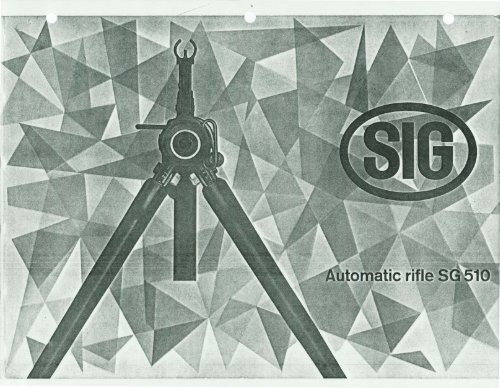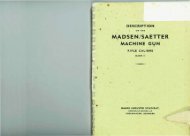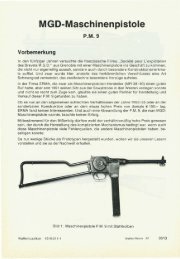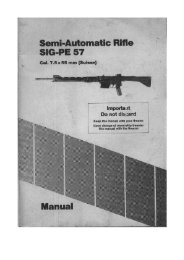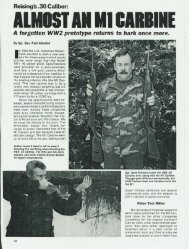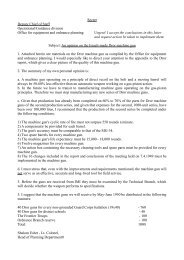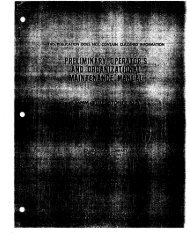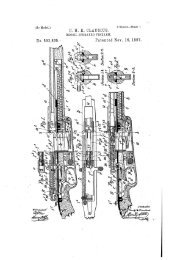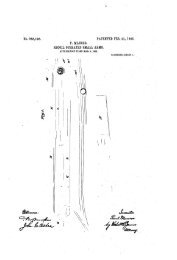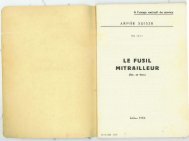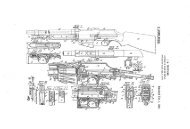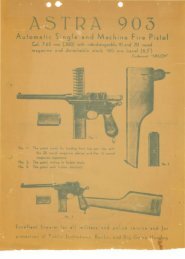S I G Automatic Rifle Type SG 510-4 - Forgotten Weapons
S I G Automatic Rifle Type SG 510-4 - Forgotten Weapons
S I G Automatic Rifle Type SG 510-4 - Forgotten Weapons
Create successful ePaper yourself
Turn your PDF publications into a flip-book with our unique Google optimized e-Paper software.
\<br />
\
\<br />
A Introduction<br />
The tactical employment of nuclear weapons in<br />
the field is a likelihood that obligates all de<br />
fense forces to reassess their organisation,<br />
weapons, equipment, and tactics. As a result,<br />
greater emphasis w i ll have to be placed on<br />
the following:<br />
Increased mobility by extended mechanisation<br />
Increased flexibil ity of individ ual units<br />
Increased fire power.<br />
Tactical units tend to become smaller and at<br />
the same time acquire greater mobility and fire<br />
power. But, even in t his age of nuclear warfare ,<br />
one cannot do without conventional weapons<br />
to arm the soldie rs fighting in small units who<br />
would otherwise be unable to attain their ob<br />
jectives.<br />
In order to increase combat efficiency new<br />
weapons are required as part of the general<br />
equ ipment of all forces, weapons which so far<br />
have been unavailable , or at least not available<br />
in sufficient quantities. The <strong>Automatic</strong> <strong>Rifle</strong> has<br />
been deve loped as a resu lt of a thorough<br />
study at tactical requirements and permits an<br />
enormous increase in fire power as compared<br />
with previous equipment.<br />
For example , an infantry platoon has so far<br />
been equipped with three lig ht machine guns<br />
which are the only automatic weapons capable<br />
of firing heavy rifle cartrid ges. As such they<br />
form the actual core of the platoon. If provided<br />
with automatic weapons this platoon would<br />
have about 30 automatic weapons for heavy<br />
ammunition as against only three as before.<br />
Apart from the increase in volume of fire the re<br />
is also the advantage of fire continuity wh ich<br />
now becomes possible. Now. it will make much<br />
less difference if one weapon is knocked out<br />
than was the case when the platoon had only<br />
three a utomatic weapons.<br />
With the <strong>Automatic</strong> <strong>Rifle</strong> it is possible, without<br />
adjustment, to fire anti-tank. smoke, or anti-per<br />
sonnel grenades. Thus, the one weapon provides<br />
both flat and curved trajectory capabilities.<br />
The <strong>Automatic</strong> Rif le also simplifies the training<br />
p roblem as it no longer bec omes ne cessary to<br />
instruct t he soldier in the use of three different<br />
arms, i.e. the rifle or automatic carbine, sub<br />
machine gun and light machine gun; all that is<br />
required now is the <strong>Automatic</strong> <strong>Rifle</strong>. This results<br />
in simplification of both training and supply.<br />
Battle experience shows that the presence of<br />
automatic arms greatly e nhances troop morale.<br />
With the <strong>Automatic</strong> <strong>Rifle</strong> every so ldier can now<br />
have such a weapon. The increased fi re power<br />
resulting effects a corresponding increase in<br />
the will to fight. The individual soldier t hus<br />
acquires increased significance as a fighter<br />
due to the feeling of superiority and security<br />
provided by his automatic rifle.<br />
Disagreement exists concerning the mission<br />
of the <strong>Automatic</strong> <strong>Rifle</strong> in combat. In some forces<br />
its primary mission is that of providing semi<br />
automatic fire with full-automatic fire reserved<br />
for emergency use only. Under these circum<br />
stances the <strong>Automatic</strong> <strong>Rifle</strong> wi II not be required<br />
to assume the role of the light machine gun<br />
and can therefore be made lighter in con<br />
struction. On the other hand , those <strong>Automatic</strong><br />
<strong>Rifle</strong>s designed to replace the light ma·chine<br />
gun are more sol idly bui It to allow greater barrel<br />
wear. This lattertype ofweapon requ ires special<br />
training for its use. These two concepts result<br />
therefore in the construction of a .. heavy .. and<br />
a ·' light ,. version of the <strong>Automatic</strong> <strong>Rifle</strong>.<br />
Another idea is to equip every soldier with a<br />
rifle capable of both semi-automatic and fu l l<br />
automatic fire. When such is the case the rifle<br />
must be of sufficiently robust construction to<br />
withstand extended periods of continuous fire.<br />
The weapon described in this brochure satisfies<br />
both requirements. Th e heavier type is intended<br />
for use as a unit weapon replacing r ifle , sub<br />
machine gun and light machine gun. whereas<br />
the lighter type is primarily designed for rapid<br />
semi-automatic fire. A version for medium<br />
ammunition is also shown .
S I G <strong>Automatic</strong> <strong>Rifle</strong><br />
<strong>Type</strong> <strong>SG</strong> <strong>510</strong>-4<br />
Technical Data<br />
Calibre 7,62 mm NATO (.30 NATO)<br />
Dimensions<br />
Length overall<br />
Length of barrel with muzzle brake<br />
Number of ri fling grooves .<br />
Weights<br />
<strong>Rifle</strong> without sling, magazine or biped, with carrying<br />
handle and wooden butt .<br />
Biped complete .<br />
Magazine, steel, for 20 rounds<br />
Barrel .<br />
Sights<br />
Aperture rear sight with range adjustable<br />
between<br />
in steps of .<br />
Lateral adjustment range .<br />
Adjustable range in elevation<br />
Sight radius<br />
Other Data<br />
Rate of firing (depending on type of ammunition):<br />
in rounds pe r minute<br />
Muzzle velocity of bu llet .<br />
W f 50.115<br />
1015 mm<br />
505 mm<br />
4<br />
4250 g<br />
200 g<br />
300 g<br />
760 g<br />
100- 600 m<br />
100 m<br />
± 2 %o<br />
± 2 %o<br />
540 mm<br />
450-620<br />
780 m/ sec<br />
___..---<br />
6 a
SIG <strong>Automatic</strong> <strong>Rifle</strong> <strong>SG</strong> <strong>510</strong>-1 (Standard)<br />
SIG A utomatic <strong>Rifle</strong> <strong>SG</strong> <strong>510</strong>-2 (Light)<br />
SIG <strong>Automatic</strong> Rif le <strong>SG</strong> <strong>510</strong>-3 (for medium ammunition)<br />
.-
Fixation, of the bayonet Weapon carried on the side Weapon slung on the back Weapon carried by means<br />
of the carrying handle
The SIG <strong>Automatic</strong> <strong>Rifle</strong> <strong>SG</strong> <strong>510</strong>-1 is designed to fire grenades, and<br />
that anti -tank grenades as wel l as anti-personnel and smoke<br />
grenades.<br />
According to the propulsive cartridges d isposable, the shooting<br />
reach of the grenades can be up to 400 m. '-'<br />
Owing to the rubber butt, the grenades can be fired from a sol id base.<br />
The muzzle incorporates an integral launcher, thus additional parts<br />
for this purpose are not required.<br />
Firing of anti-tank grenades<br />
Firing of anti-personnel grenades<br />
Firing of smoke grenades<br />
-- ---, ', ' ' ' ' ' ' ' \<br />
\ \
\<br />
C Design Features<br />
Employment<br />
The <strong>Automatic</strong> <strong>Rifle</strong> is used as a unit weapon ,<br />
i.e. it replaces conventional rifles, self-loading<br />
rifles,sub-machine guns and I ight machineguns.<br />
<strong>Type</strong>s of Fire<br />
It is possible to fire both semi- and ful l-auto<br />
matic with fire selection effected by a simple<br />
lever movement.<br />
Fire Power<br />
The weapon is so designed that very rapid<br />
single shots or short bursts with a total of up<br />
to 150 rounds can be f ired without interruption<br />
for cooling and without danger of spont aneous<br />
firing (cook-off). This volume of fire is made<br />
possible mainly by robust barrel construction.<br />
(<strong>SG</strong> <strong>510</strong>-1)<br />
Reliability<br />
The weapon has been successfully tested under<br />
extre mely d ifficult conditions, such as sand.<br />
dirt, cold , rain , moisture, heat, etc., and will<br />
fun ction rel iably.<br />
Accuracy<br />
When used for a imed fire the accuracy of the<br />
<strong>Automatic</strong> <strong>Rifle</strong> is com parable to that of a good<br />
manually operated rifle ; but due to t he auto-<br />
matic loading mechanism the rate of fire is<br />
much greater. When fired in bursts dispersion<br />
is very small despite of the light weight of the<br />
weapon , due to the small recoil, and is com<br />
parable to that of a light machine gun.<br />
Recoil<br />
Due to unique breech design recoil of the<br />
<strong>Automatic</strong> <strong>Rifle</strong> is only about 35 °/ 0 of that<br />
developed by a conventional rifle. This reduced<br />
recoil increases the accuracy potential of the<br />
weapon when fired by individuals sensitive to<br />
recoil.<br />
Straight Buttstock<br />
The straight stock results in straightline de<br />
livery of recoil to t he shooter's shoulder which<br />
eliminates tendency of the muzz le to climb<br />
when firing bursts. Effective full-automatic fire<br />
can thus be delivered on point targets without<br />
waste of ammunition.<br />
Handling Qualities<br />
Due to optimum weight and shape character<br />
istics the <strong>Automatic</strong> <strong>Rifle</strong> does not dec rease<br />
mobility of the soldier and can be quickly<br />
brought into action from any position.<br />
Carrying<br />
Location of the carrying handle at the center<br />
of gravity, or bal ance point. makes the weapon<br />
,.,<br />
convenient to carry. On the march the Auto<br />
matic <strong>Rifle</strong> may be slung on the back or in front,<br />
or carried on the side.<br />
Firing of Grenades<br />
The <strong>Automatic</strong> <strong>Rifle</strong> with rubber butt is designed<br />
to fire anti-tank, smoke, or anti-personnel<br />
grenades from a solid base at a steep elevation.<br />
The muzzle incorporates an integral launcher,<br />
thus additional parts for this purpose are not<br />
required.<br />
Ammunition<br />
<strong>Rifle</strong>s described in this brochure are designed<br />
for f iring the standard heavy rifle round thereby<br />
simplifying ammunition supply and at the same<br />
time providing effective flat trajectory fire.<br />
The <strong>Rifle</strong> <strong>Type</strong> <strong>SG</strong> <strong>510</strong>-3 is designed for lighter,<br />
so-called " medium " ammunition.<br />
Operation of the Weapon<br />
Operation of the weapon is simple and com<br />
ponent parts are designed to prevent incorrect<br />
assembly. This results in appreciable saving in<br />
training time.<br />
Simple Manufacture<br />
Components can be produced easily and<br />
cheap y by modern mass production methods,<br />
includ ing welding , punching, etc., and parts<br />
11
are fully interchangeable. Steel required is<br />
mostly unall oyed , or low-quality alloyed. High<br />
quality alloys required are available com<br />
mercially. In short, raw materials requ ired for<br />
manufacture of the rifle are likely to be read ily<br />
available even in times of material shortages.<br />
Simple Maintenance<br />
The rifle is readi ly stripped down for mainte<br />
nance w ithout use of special tools. Ordinary<br />
rifle o'il is adequate for lubrication.<br />
Safety<br />
The weapon can bei loaded, un loaded, stripped,<br />
and assembled, with safety engaged. A loading<br />
indicator shows presence of a round in the<br />
chamber.<br />
._,<br />
D Description<br />
General<br />
The <strong>Automatic</strong> <strong>Rifle</strong> <strong>SG</strong> <strong>510</strong> features a novel<br />
design principle and can be regulated for f iring<br />
single rounds o r continuous bursts. It is not<br />
recoi I operated ; the barrel is firmly attached<br />
to the breech case and does not move. Ne ither<br />
is it gas operated in the conventio nal sense as<br />
no gas piston is present. The cartridge case<br />
alone is used to f unction the breech mechanism.<br />
The rifle fires from closed breech position with<br />
ammunition magazine-fed from below. Fired<br />
cartridge cases are ejected to the r ight .<br />
Anti-tank grenades can be f ired with muzzle<br />
brake in position and without a special launcher.<br />
The bayonet can be fixed with muzzle :brake<br />
in position.<br />
Components<br />
Breech Case<br />
The central portion of the breech case, which<br />
guides the breech, is of sheet steel. The car<br />
tridge ejector opening and loading handle guide<br />
are on its right side. The rear aperture sight<br />
is also present on this portion which is welded<br />
to the forged casing head containing the locking<br />
sockets for the breech rollers and the loading<br />
indicator. The carrying handle is fixed to the<br />
front portion of the casing head.<br />
The rear po rtion of the sheet steel breech<br />
casi ng is joined to the center section by a<br />
bayonet attachment. This part supports the butt<br />
and recoil spring housing containing the recoil<br />
spring.<br />
Barrel Casing<br />
The barrel casing is a slotted light alloy tube<br />
with front sight carrier and bayonet lug at its<br />
front end. The bipod , which can be locked in<br />
rear or forward position, slides on the barrel<br />
casing.<br />
A bridge connects the barrel casing with the<br />
casing head.<br />
Barrel<br />
The barre l muzzle, designed as a grenade<br />
launcher, also accomodates the muzzle brake.<br />
A spring catch secures grenades for minus<br />
angle of sight firing.<br />
The cartridge chamber has fluted walls.<br />
Breech<br />
The breech comprises a breech head with<br />
ejector, locking rollers with rockers and car<br />
tridge holder, rear d irector shaft with firing<br />
pin and firing pin spring , and the firing lever.<br />
Breech head and director shaft are connected<br />
by a cotter p in .<br />
_ _.......
Rubber butt<br />
2 Rear portion of breech-casing<br />
3 Bayonet attachment<br />
4 Recoil spring<br />
5 Aperture sight<br />
6 Center section of breech-casing<br />
7 Carrying handle<br />
8 Casing head<br />
9 Locking sockets<br />
10 Spring catch<br />
11 Barrel casing<br />
12 Front sight carrier w ith front sight<br />
13 Muzzle with integral grenade launcher<br />
14 Muzzle brake<br />
15 Biped<br />
16 Magazine<br />
17 Operating handle<br />
18 Bolt to the trigger casing<br />
19 Trigger mechanism<br />
20 Breech<br />
21 Aperture f or strap<br />
I I I<br />
I<br />
1
\<br />
E Operation<br />
___...--·<br />
........---<br />
A pull on the trigger releases the hammer to<br />
strike the firing lever wh ich drives the firing<br />
pin forward, firing the cartridge.<br />
The resultant chamber pressure obturates the<br />
cartridge case against the walls of the fluted<br />
chamber and also forces the case against the<br />
breech head. The rollers lie in their locking<br />
sockets preventing the breech head from<br />
yielding. This is not a rigid lock as the rollers<br />
are forced into their sockets by the wedge<br />
shaped faces of the director shaft, which is<br />
held in forward position only by pressure of the<br />
recoil spring assembly.<br />
As the bullet accelerates up the bore and<br />
breech pressure increases, the director shaft<br />
is forced to the rear, and after about one<br />
quarter inch of travel the locking rollers turn<br />
inwards enabling the breech head to move<br />
rearwards with the fired cartridge case. The<br />
director shaft has stored sufficient energy to<br />
completely unlock the breech and pull it back<br />
against resistance of the spring. During this<br />
rearward movement the cartridge case is<br />
extracted.<br />
The ejector runs on to a cam pressed into t he<br />
casing and ejects the case to the right. During<br />
rearward movement of the breech the hammer<br />
is cocked and t he recoil spring compressed.<br />
--.<br />
1
Trigger Operation<br />
Semi-<strong>Automatic</strong> Fire<br />
To fire sing le ro und the safety catch is set to<br />
" E" ; t he trigge r tongue can then be pulled<br />
back.<br />
Safety catch<br />
2 Trigger tongue<br />
3 Trigger spring<br />
4 Axle of trigger tongue and trigger rod<br />
5 Trigger rod<br />
6 Hammer<br />
7 Catch joint<br />
8 Trigger rod spring<br />
The catch joint connects the trigger t ongue<br />
with t he trigger rod. The hammer is he ld back<br />
by the trigger rod.<br />
1!
lO<br />
'.··<br />
E<br />
E<br />
When the trigger tongue which pivots on the<br />
axle is pulled back, the trigger rod is turned<br />
round, since it rests on the same spindle.<br />
The trigger rod then disengages to release the<br />
hammer which is struck forward by the cocked<br />
firing spring.<br />
Safety catch<br />
2 Trigger t ong ue<br />
3 Trigger spring<br />
4<br />
5<br />
6<br />
7<br />
A xle of trigger tongue and trigger rod<br />
Trigger rod<br />
Hammer<br />
Catch joint<br />
8 Trigger rod spring<br />
9 Firing spring<br />
10 Bell crank lever<br />
11 Bell crank lever pin<br />
12 Ful l-automatic firing pawl<br />
Then, the trigger rod which rests in an oval<br />
hole, is pressed forward and upward by the<br />
eccentrically supported trigger rod spring,<br />
which disconnects the catch joint from the<br />
trigger rod. The trigger rod is then repo.si-<br />
tioned to engage the hammer. ·
After the hammer has returned to cocked<br />
position, the f iring spring forces the trigge r<br />
rod back again by means of the hammer pro<br />
jection. To fire the next round the t rigger<br />
tongue must be released, it is then pul led for<br />
ward by the trigger spring. W hen the trigger<br />
tongue reaches its forward position the catch<br />
joint engages forward into the trigger rod. This<br />
cycle of operation is repeated as l ong as single<br />
shots are fired .<br />
Full-<strong>Automatic</strong> Fire<br />
By setting the safety catch to ·' M·· , the bell<br />
crank lever is pushed forward and upward, so<br />
that the bell c rank lever pin assumes a vertical<br />
position between the full-automatic f iring pawl<br />
and the trigger rod .<br />
·E<br />
M<br />
2 5 4 11 12 6 10 8 7 3<br />
.. . \
Disassembly<br />
----<br />
Hold rifle in left hand by means of pistol grip.<br />
Hold magazine with right hand and at same time<br />
press forward on magazine catch and remove<br />
magazine to front.<br />
Hold rear portion of breech casing with right<br />
hand and press catch with index finger. Rotate<br />
butt 1 / 8 turn counter-clockwise and withdraw it<br />
to rear. Withdraw locking handle and remove<br />
towards right.<br />
Remove breech.<br />
Press spring of trigger casing bolt inward and<br />
push bolt out to right. Hinge trigger mechani sm<br />
downward and withdraw it to rear.<br />
No further dismantling is required for cleaning<br />
purposes. Care should be taken that hammer<br />
is not released until weapon has been com<br />
pletely assembled.<br />
Stripping the breech<br />
Set breech to stripping position by separating<br />
breech head and d irector shaft about 5 mm<br />
apart. Using tip of recoil spring push transverse<br />
key from right to left and remove it. Separate<br />
breech head and director shaft.<br />
Release outer ejector spring by drawing longer<br />
arm of spring (with twist) across leg of ejector<br />
and remove spring. Remove stop bolt.<br />
Turn ejector to left and lift out.<br />
Reverse breech head and t ap out roller holder.<br />
Rollers and rockers can now be removed.<br />
Smartly tap top edge of d irector shaft against<br />
a wooden surface to dislodge firing lever pin<br />
from its support so that it can be removed.<br />
Place a f inger on rear portion of director shaft<br />
and remove firing lever towards r ight-hand<br />
side. Due to force of the spring the firing pin<br />
will be forced backwards.<br />
Remove firing pin and its spring.<br />
Assembly<br />
To assemble the weapon perform above oper<br />
ations in reverse order. Note: Firing pin is<br />
forced to the rear by means of the transverse<br />
key, so that firing lever can be inserted.<br />
,..,<br />
2E


